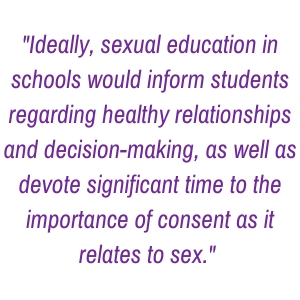Essay Winner: Sophia McGaff
 We asked students to write about the following prompt: At what age do you believe victim blaming begins to occur for children and youth experiencing sexual assault and gender-based violence, and what would prevention practices look like in your school or community?
We asked students to write about the following prompt: At what age do you believe victim blaming begins to occur for children and youth experiencing sexual assault and gender-based violence, and what would prevention practices look like in your school or community?
The essays we received spoke to the thoughtfulness and compassion of the youth in our community, and we were honored for them to participate in our essay competition, that asked them to engage with their communities to identify, and offer ideas to address, the victim-blaming they experience.
Thank you again to our sponsors who helped contribute to the scholarship fund and assistance with #DenimDay: Independence State Bank, Infinity Training & Consulting, CCF Bank, Citizens First Bank, Associated Bank, Shayla Butz, Peter Ruud, Sandra Chase, Brenda Liebig, Abby Liebig, Verve–a Credit Union, Jane and Joseph Michalke, Bluff View Bank, Heather Holley, Lori and Mark Meinking, and Scott and Laurie Kopp.
The top prize was a $500 scholarship for continuing education and a Kwik Trip gift card. The following is the winning essay from Sophia McGaff of Logan High School in La Crosse.
When confronted with the reality of sexual assault and gender-based violence, our culture is quick to look for sources of blame for this horrendous occurrence. Unfortunately, this blame often falls to the victim of the crime. In trying to make sense of terrible things that happen to innocent people, our society is quick to point out surface-level details that convince us that the same thing will not happen to us. Blame is assigned to the victim based on a culture that trivializes sexual violence, reinforces gender-based stereotypes concerning sexuality, and teaches youth “how not to be sexually assaulted” rather than addressing the root causes of sexual violence.
 These attributions of blame may be ascribed to victims of all ages. But are likely to become more common when the victim’s age is culturally associated with the ability to participate in romantic relationships and give consent for sex. While it is impossible to give a specific age at which a victim of sexual assault is likely to be blamed for their own assault, some common sources of victim-blaming tendencies may reveal developmental markers at which the practice becomes much more likely. These can include: ages at which children are exposed to sexual education practices that teach “how not to be assaulted” rather than addressing causes of sexual violence, ages at which children are exposed to gender-based stereotypes concerning sexuality, and ages at which they are culturally sexualized.
These attributions of blame may be ascribed to victims of all ages. But are likely to become more common when the victim’s age is culturally associated with the ability to participate in romantic relationships and give consent for sex. While it is impossible to give a specific age at which a victim of sexual assault is likely to be blamed for their own assault, some common sources of victim-blaming tendencies may reveal developmental markers at which the practice becomes much more likely. These can include: ages at which children are exposed to sexual education practices that teach “how not to be assaulted” rather than addressing causes of sexual violence, ages at which children are exposed to gender-based stereotypes concerning sexuality, and ages at which they are culturally sexualized.
It is also important to acknowledge that while sexual assault and gender-based violence can, and do, occur separately, this essay will examine sexual assault as a crime that is often associated with gender-based violence. Cultural trivialization of sexual violence and victim-blaming are often is associated with stereotypes that excuse violent sexual behavior in men, and perpetuate phrases like “boys will be boys.” This is not to say that men and boys are not also victims of sexual assault; one out of ten victims are male. However, the majority of victims of sexual assault are women and girls, and cultural tendencies that perpetuate victim-blaming often occur at their expense.
 Ideally, sexual education in schools would inform students regarding healthy relationships and decision making, as well as devoting significant time to the importance of consent as it relates to sex. However, the topics of sexual assault and consent are not mandated in Wisconsin curriculum, which adopted an “abstinence-only” curriculum in 2010.
Ideally, sexual education in schools would inform students regarding healthy relationships and decision making, as well as devoting significant time to the importance of consent as it relates to sex. However, the topics of sexual assault and consent are not mandated in Wisconsin curriculum, which adopted an “abstinence-only” curriculum in 2010.
Also not mandated in Wisconsin, is a curriculum that explicitly addresses cultural stereotypes that perpetuate victim-blaming. When children are taught that abstinence is the only acceptable option for their future relationships leading up to marriage, they are being culturally deemed ready to deny and avoid all sexual behaviors consensual or not.
If a child, who has experienced our state’s less than adequate sexual health curriculum, is sexually assaulted, many may assume the child is at fault, because they should have been educated to refuse sex in all forms by their school curriculum. This form of victim-blaming cites a child’s “abstinence-only” sexual education as grounds to blame any resulting assault on their faulty adherence to school curriculum intended to teach them “how not to be sexually assaulted”. When school curriculum ignores the root causes of sexual assault and insists that teaching abstinence is the correct way to prevent sexual assault, they have effectively blamed any resulting non-consensual sexual behavior on the student’s failure to utilize the provided curriculum.
When students exposed to less than comprehensive sexual education in schools are viewed by adults as able to understand the concept of consent, they are likely to be viewed with a higher degree of responsibility towards any potential sexual assault. This ignores the fact that sexual education most often does not properly teach consent, but also ignores the fact that students should not have to be taught “how not to be sexually assaulted”. Victim blaming tendencies begin to occur at any time in which students are asked to take responsibility for their own sexual assault prevention.
Unfortunately, the prevalence of victim-blaming as it relates to sexual assault is often justified by faulty, and harmful gender-based stereotypes of sexuality. When considering this topic, “boys will be boys” is often a phrase that comes to mind. Girls are often taught ways to avoid sexual assault that blame assault on women not understanding male sexualities, and excuse men from the responsibility of their behaviors for the same reason. Certified sex therapist Laura Rademacher states that culturally, we excuse jokes that trivialize sexual assault as merely jokes about “real men”.
 Dress codes in schools have been justified as ways to prevent boys from “getting distracted”. These faulty perceptions of male sexuality are commonly used to excuse sexually violent behaviors and discourage adequate disciplinary responses. When men are not held responsible for their sexual actions, and this responsibility is transferred to the women around them, victim-blaming is made much more likely. As soon as girls are exposed to these harmful assumptions concerning sexuality, they are expected by society to be able to prevent their own assault. Exposure to gender-based sexual stereotypes creates a perception that a girl who was sexually assaulted “should have known better” and is thus responsible for her own assault.
Dress codes in schools have been justified as ways to prevent boys from “getting distracted”. These faulty perceptions of male sexuality are commonly used to excuse sexually violent behaviors and discourage adequate disciplinary responses. When men are not held responsible for their sexual actions, and this responsibility is transferred to the women around them, victim-blaming is made much more likely. As soon as girls are exposed to these harmful assumptions concerning sexuality, they are expected by society to be able to prevent their own assault. Exposure to gender-based sexual stereotypes creates a perception that a girl who was sexually assaulted “should have known better” and is thus responsible for her own assault.
These dangerous assumptions could be addressed by actively combating gender-based sexual stereotypes in schools, and adequately disciplining behaviors that trivialize sexual assault. A thorough conversation must be held with students regarding the harmful nature of toxic masculinity. It should be emphasized that women should not be expected to take responsibility for the actions of men.
Teaching the importance of consent in healthy relationships to students of all genders and sexual orientations is critical, so is avoiding teaching practices that place responsibility for preventing sexual assault on students themselves. Perceptions that children who are exposed to stereotypes concerning sexual behavior should understand how to prevent sexual assault should be discouraged in favor of those that recognize the fact that sexual assault is exclusively the fault of the perpetrator.
Sexualization of children can contribute to victim-blaming by indirectly asserting that children can understand and provide consent for sex. This sexualization occurs in many facets of life from advertisements that portray young children in sexualized roles, to the perpetuation of a “sexy schoolgirl” image in the media. An excellent example of cultural sexualization of children can be seen in the tone of many school dress codes. When students, especially girls, are asked to cover certain parts of their bodies, a message is sent that these body parts are inherently inappropriate.
The sexual tone of many dress codes contributes to the sexualization of children by implying that non-sexual areas of their bodies such as shoulders should be kept hidden to the same degree as areas like breasts and genitals. Of 481 schools surveyed by journalist Amber Thomas, the number one “prohibited” body area was the midsection (far from an inherently sexual body part.) By asking students to cover areas of their body deemed sexual, or immodest by adults, a message is sent that children should be responsible to protect themselves from their own cultural sexualization.
Many schools justify their dress codes as ways to prevent the discomfort of others, not for the student’s interest or benefit. The dress code of Wausaukee High School in Wisconsin states “Students are encouraged to ask themselves… Does my choice of clothing make others around me uncomfortable? Does my clothing expose too much?”
In creating dress codes that ask students to consider whether their body makes others around them uncomfortable, it is conveyed that inappropriate, sexualized perceptions are the fault of a student’s dress, and not the fault of an adult who is viewing children in a sexual context. When children are considered responsible for other’s sexual perceptions of their bodies, potential sexual assault is more likely to deemed the consequence of a child who dressed like they “wanted it” or failed properly distance themselves from the sexualized image of children often shown in media.
While a complete abolition of dress codes in schools would not solve the issue of child sexualization, schools could remove any wording that implies that student’s bodies are a “distraction” or that a dress code is a “safety” issue from their respective policies. Phrasing involving the words “distraction” was found in 76% of surveyed dress codes, and “safety” was found in 65%. School and community policies that view measures like dress codes as an effective method of preventing “distraction” and “safety” issues do prevent sexual assault, but actually encourages sexualization of children and perpetuate the notion that children are responsible for their sexualized perception by adults.
 No definite age exists at which children become significantly more likely to be blamed for their own sexual assault. According therapist and expert witness Rhonda Bryhn, victims as young as two years old can be subjected to victim blaming. However, victim-blaming tendencies are more likely to be expressed when children are deemed as able to effectively prevent unwanted sexual activity, are associated with gender-based preconceptions of sexuality, and are viewed at all in a sexual context by adults. Community and school prevention practices should address the root causes of sexual assault, and not place responsibility directly by blaming victims, or indirectly, by implementing practices and policies that teach children how to prevent their own assault. These can include, but should not be limited to: comprehensive sexual education in schools (including a thorough discussion of consent), removal of sexualized wording from school and community dress-code policies, and the end of all practices that place responsibility on children for their own sexualization and assault.
No definite age exists at which children become significantly more likely to be blamed for their own sexual assault. According therapist and expert witness Rhonda Bryhn, victims as young as two years old can be subjected to victim blaming. However, victim-blaming tendencies are more likely to be expressed when children are deemed as able to effectively prevent unwanted sexual activity, are associated with gender-based preconceptions of sexuality, and are viewed at all in a sexual context by adults. Community and school prevention practices should address the root causes of sexual assault, and not place responsibility directly by blaming victims, or indirectly, by implementing practices and policies that teach children how to prevent their own assault. These can include, but should not be limited to: comprehensive sexual education in schools (including a thorough discussion of consent), removal of sexualized wording from school and community dress-code policies, and the end of all practices that place responsibility on children for their own sexualization and assault.

